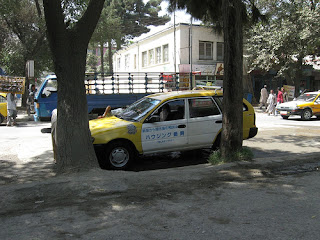Well, it all starts in, you guessed it, Japan. White is by far the most popular car color in Japan, whether you're a middle class housewife with a Corolla sedan or a Ricoh copy machine repair guy with a company-owned Corolla wagon. The only difference being, the commercial wagon has the company logo, telephone number, and random advert words stenciled on the body panels.
 The other Corolla ad I could have posted starred Peter Falk (as Columbo)
The other Corolla ad I could have posted starred Peter Falk (as Columbo)Due to Draconian inspection regulations meant to stimulate the domestic auto industry, Japanese cars in Japan become prohibitively expensive to keep after three years. Millions of low mileage (100,000 kilometers), reliable, and well maintained cars and vans flood the non-existent Japanese used car market annually.
In the first half of 2005, auction houses throughout Japan exported 350,000 used vehicles. Most head to either Vladivostok for the insatiable Russian Far East market or Dubai, where they end up in South Asia or East Africa.
Savvy Pakistani businessmen buy the cars from the Japanese auction houses and have them shipped to Dubai. There, Afghan expats buy them and ship them to Bandar-e-Abbas, on the Iranian coast. There, the cars, still in their containers, are shipped overland to the frontier town of Islam Qala. The cars are then driven over the Afghan border to Herat, where they sit in huge car lots owned and operated by a few Kandahari families. Finally, the Corollas are driven to Kabul, where they are painted partially yellow. However, the Japanese characters, logos, and telephone numbers are kept in place, as they are evidence that the car was Japanese, well taken care of, and most importantly, reliable.
In the first half of 2005, auction houses throughout Japan exported 350,000 used vehicles. Most head to either Vladivostok for the insatiable Russian Far East market or Dubai, where they end up in South Asia or East Africa.
Savvy Pakistani businessmen buy the cars from the Japanese auction houses and have them shipped to Dubai. There, Afghan expats buy them and ship them to Bandar-e-Abbas, on the Iranian coast. There, the cars, still in their containers, are shipped overland to the frontier town of Islam Qala. The cars are then driven over the Afghan border to Herat, where they sit in huge car lots owned and operated by a few Kandahari families. Finally, the Corollas are driven to Kabul, where they are painted partially yellow. However, the Japanese characters, logos, and telephone numbers are kept in place, as they are evidence that the car was Japanese, well taken care of, and most importantly, reliable.
 Suburb of Kabul or Yokohama?
Suburb of Kabul or Yokohama?In 2005, a 1992 to '94 Corolla in good condition sold for $5,400 to $6,800 in Kabul. Importers of right hand drive Corollas took a beating recently when the Afghan government banned the import of all right hand drive vehicles. Investors lost their shirts on that gamble.
 In this consumerist and disposable world, it's good to see perfectly fine cars being used to its maximum (and beyond) potential. These Corollas are used by hard working entrepreneurs ad infinitum.
In this consumerist and disposable world, it's good to see perfectly fine cars being used to its maximum (and beyond) potential. These Corollas are used by hard working entrepreneurs ad infinitum. I must say, though, it was extremely difficult to find any decent photographs of the ubiquitous Kabuli Corolla taxi on the net. Their importance is taken for granted. They merely blend into the bleak and dusty background. But if anything will raise the phoenix from the ashes that is the Afghan capital, it is the peppy Corolla. Fight on!
I must say, though, it was extremely difficult to find any decent photographs of the ubiquitous Kabuli Corolla taxi on the net. Their importance is taken for granted. They merely blend into the bleak and dusty background. But if anything will raise the phoenix from the ashes that is the Afghan capital, it is the peppy Corolla. Fight on! CKY
CKY*Big thanks to Anna Paterson of AREU for her extensive research on a topic only she and I care about. Read her 31 page pdf tome on the subject on AREU's website.









No comments:
Post a Comment